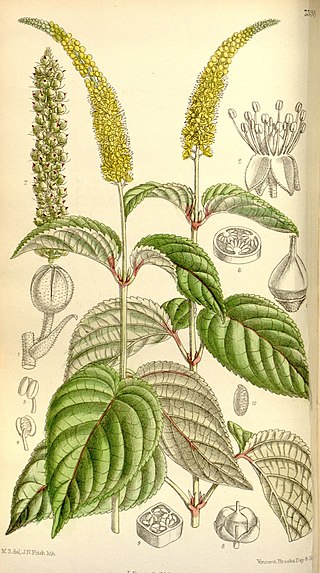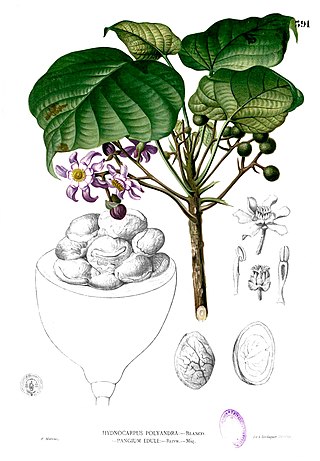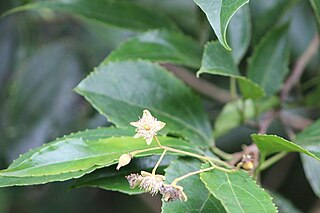
The Salicaceae are the willow family of flowering plants. The traditional family included the willows, poplars. Genetic studies summarized by the Angiosperm Phylogeny Group (APG) have greatly expanded the circumscription of the family to contain 56 genera and about 1220 species, including the tropical Scyphostegiaceae and many of the former Flacourtiaceae.

The Flacourtiaceae is a defunct family of flowering plants whose former members have been scattered to various families, mostly to the Achariaceae and Salicaceae. It was so vaguely defined that hardly anything seemed out of place there and it became a dumping ground for odd and anomalous genera, gradually making the family even more heterogeneous. In 1975, Hermann Sleumer noted that "Flacourtiaceae as a family is a fiction; only the tribes are homogeneous."

Abatia is a genus of about ten species of Central and South American trees in the family Salicaceae. Previously, it was treated in the family Flacourtiaceae, or tribe Abatieae of the family Passifloraceae or Samydaceae by G. Bentham & J.D. Hooker and Hutchinson.

Achariaceae is a family of flowering plants consisting of 31 genera and about 155 species of tropical herbs, shrubs, and trees. The APG IV system has greatly expanded the scope of the family by including many genera previously classified in Flacourtiaceae. Molecular data strongly support the inclusion of this family in the order Malpighiales.

Samydaceae is a family of tropical and subtropical woody plants, its best known genus being Casearia. It has always been of uncertain placement, in the past usually being submerged in the family Flacourtiaceae.

Macrohasseltia is a monotypic genus of flowering plants in the family Salicaceae. It consists of one species of tree: Macrohasseltia macroterantha, which is native to Central America. Formerly placed in the heterogeneous family Flacourtiaceae, Macrohasseltia is now classified in Salicaceae, along with close relatives Bennettiodendron, Carrierea, Idesia, Itoa, Olmediella, Poliothyrsis, and even the willows (Salix) and cottonwoods (Populus) themselves.

Aphaerema was formerly a genus of flowering plants in the Flacourtiaceae, consisting of one species of small shrubs, Aphaerema spicata, which is native to Brazil and Argentina. Later studies indicated that Aphaerema should be classified in the willow family, Salicaceae, and combined with the genus Abatia. Because the name Abatia spicata was already used, the species was given the new name Abatia angeliana, in honor of Brazilian botanist João Angely. Aphaerema is one of the few groups of Salicaceae with opposite leaves.
Hasseltiopsis is a monotypic genus of flowering plants in the family Salicaceae. It consists of one species of trees: Hasseltiopsis dioica, which is native to Central America. Formerly placed in the heterogeneous family Flacourtiaceae, Hasseltiopsis is now classified in Salicaceae, along with close relatives Prockia, Pineda, Neosprucea, and Banara.
Scyphostegia borneensis is a species of shrub or small tree endemic to Borneo. This unusual plant is the only species in the genus Scyphostegia. In many taxonomic classifications the genus was placed in its own family, the Scyphostegiaceae. Analyses of DNA data indicated that the species is related to a group of species of the now defunct Flacourtiaceae, a group which is now placed in a broadly circumscribed Salicaceae.
Ahernia is a genus of a single species, Ahernia glandulosa, a tree in the family Achariaceae, native to Hainan and Luzon island of the Philippines. Previously it was treated in the family Flacourtiaceae before being placed in Achariaceae. Ahernia is closely related to the American genera Hasseltia, Macrothumia, and Pleuranthodendron, but differs in its axillary racemes and more numerous (10–15) petals. Ahernia glandulosa is found in low elevation primary forests and is known in the Tagalog language as butun or sanglai. It grows 8–15 m (26–49 ft) tall.
Euceraea is a genus of flowering plants in the family Salicaceae. The genus is native to north South America throughout the North Region of Brazil, Colombia, Guyana, Suriname, and Venezuela.
Irenodendron is a genus of flowering plants in the family Salicaceae native to northern South America.

Osmelia is a genus of flowering plants in the willow family, Salicaceae. Osmelia includes four species of trees native to Sri Lanka and Southeast Asia. Osmelia is closely related to the monotypic Pseudosmelia of Morotai and Halmahera of the Indonesian Maluku Islands and to the monotypic Ophiobotrys from west and west-central tropical Africa.

Zuelania guidonia is a species of shrub or tree native to the West Indies, Central America, and northern South America and is the only member of the genus Zuelania. Formerly classified in the Flacourtiaceae, phylogenetic analyses based on DNA data indicate that this species, along with its close relatives in Casearia, Samyda, Hecatostemon, and Laetia, are better placed in a broadly circumscribed Salicaceae. Zuelania differs from its close relatives in having a large, subsessile stigma.
Ophiobotrys zenkeri is a species of flowering plant in the family Salicaceae. It is a tree native to tropical Africa from Ivory Coast to Gabon and is the only member of the genus Ophiobotrys. Formerly classified in the Flacourtiaceae, phylogenetic analyses based on DNA data indicate that this species, along with its close relatives in the Asian genera Osmelia and Pseudosmelia, are better placed in a broadly circumscribed Salicaceae. Ophiobotrys differs from its close relatives in having 5 sepals, 5(-6) stamens, one divided style, and terminal inflorescences.
Pseudosmelia moluccana is a species of shrub or small tree native to Morotai and Halmahera of the Indonesian Maluku Islands and is the only member of the genus Pseudosmelia. Formerly classified in the Flacourtiaceae, phylogenetic analyses based on DNA data indicate that this species, along with its close relatives in the Asian genus Osmelia and the African genus Ophiobotrys, are better placed in a broadly circumscribed Salicaceae. Pseudosmelia differs from its close relatives in having thick, truncate staminodes and large, spindle-shaped fruits with numerous seeds.

Macrothumia is a genus in the willow family Salicaceae with a single species Macrothumia kuhlmannii. It is a tree native to the states of Bahia, Espírito Santo, and Minas Gerais in Brazil. Formerly classified in the genus Banara in the family Flacourtiaceae, phylogenetic analyses based on DNA data indicate that this species, along with its close relatives in Ahernia, Hasseltia, and Pleuranthodendron are better placed in a broadly circumscribed Salicaceae. Macrothumia differs from its close relatives in having a congested fascicle- or umbel-like inflorescence and a large fruit. The genus name is derived from the Greek word μακροθυμία, which means long-suffering and enduring patience.

Prockia is a genus of flowering plants in the family Salicaceae. It consists of approximately six species of shrubs and small trees native to the West Indies, Mexico, Central America, and South America. Its type species, Prockia crucis, is highly polymorphic and has a broad distribution, from Mexico and the West Indies to Uruguay and northern Argentina.
Hecatostemon completus is a species of shrub or tree native to northeastern South America and is the only member of the genus Hecatostemon.
Tisonia is a genus of flowering plants belonging to the family Salicaceae. It is also in the subfamily Salicoideae and tribe Saliceae.










